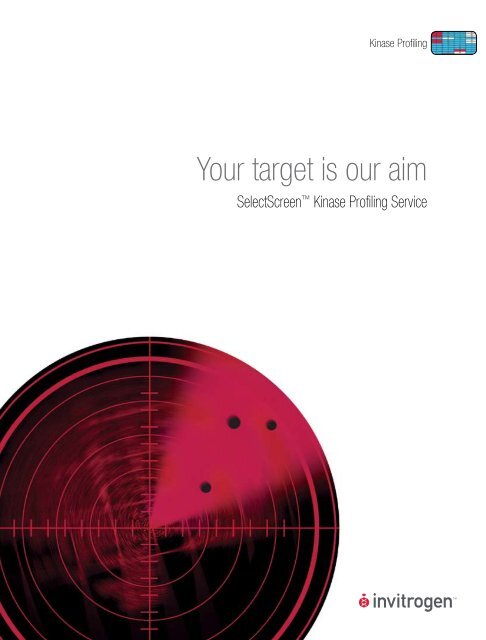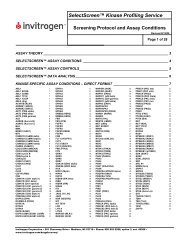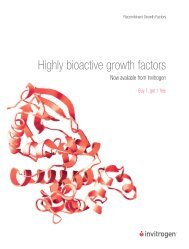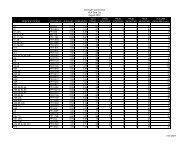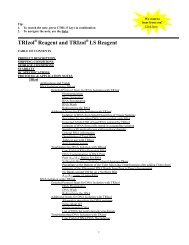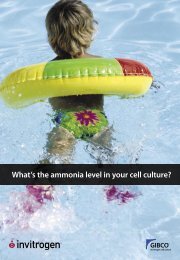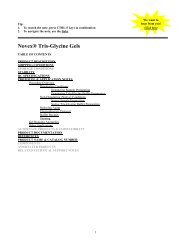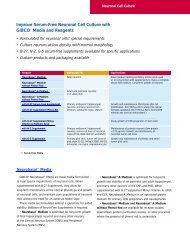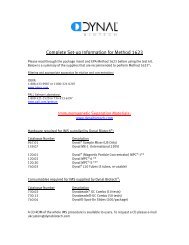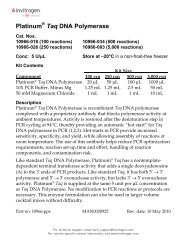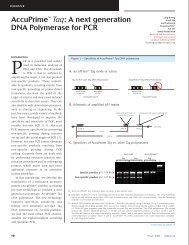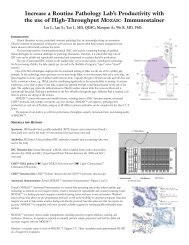Your target is our aim - Invitrogen
Your target is our aim - Invitrogen
Your target is our aim - Invitrogen
Create successful ePaper yourself
Turn your PDF publications into a flip-book with our unique Google optimized e-Paper software.
Kinase Profiling<br />
<strong>Y<strong>our</strong></strong> <strong>target</strong> <strong>is</strong> <strong>our</strong> <strong>aim</strong><br />
SelectScreen Kinase Profiling Service
Kinase Profiling<br />
People and process<br />
make all the difference<br />
SelectScreen Kinase Profiling Service<br />
→<br />
→<br />
→<br />
Understand compound selectivity and potency across a broad panel<br />
of kinase <strong>target</strong>s<br />
Evaluate compound activity against d<strong>is</strong>ease-relevant kinase mutants<br />
Identify ATP-competitive and allosteric modulators of kinase activity<br />
<strong>Invitrogen</strong>’s SelectScreen Profiling Services give you the data you need to make smart dec<strong>is</strong>ions<br />
sooner. In drug d<strong>is</strong>covery, every delay costs. For fast turnaround of high-quality data, trust the<br />
SelectScreen Kinase Profiling Service. From enzyme and biochemical assay generation to com-<br />
pound screening, we have developed highly controlled processes to ensure data accuracy. Our<br />
commitment to y<strong>our</strong> research means we deliver y<strong>our</strong> data on schedule. Because if you’re sitting<br />
on the next development candidate, wouldn’t you rather know sooner?<br />
<strong>Invitrogen</strong>’s SelectScreen Kinase Profiling Service brings together the power of <strong>our</strong> puri-<br />
fied protein kinase <strong>target</strong>s and <strong>our</strong> robust Z’-LYTE biochemical assay technology to create the<br />
premier outs<strong>our</strong>ced service on the market.<br />
Built-in quality<br />
All SelectScreen services are performed with reagents manufactured at <strong>Invitrogen</strong>’s Mad<strong>is</strong>on,<br />
W<strong>is</strong>consin D<strong>is</strong>covery Sciences facility. Th<strong>is</strong> ensures the integrity and quality of the reagents. Fur-<br />
thermore, you can purchase all of the reagents used in the service for any internal follow-up work.<br />
Control or reference inhibitor compounds are present for each kinase we assay on every plate<br />
of client compounds. All services are performed in duplicate (n = 2). All services are completely<br />
confidential. Our open business model allows for flexible, volume-based project d<strong>is</strong>counts. With<br />
the addition of <strong>our</strong> new SelectScreen facility in Scotland, <strong>Invitrogen</strong> now has a global presence.<br />
Th<strong>is</strong> allows for more streamlined compound subm<strong>is</strong>sion and real-time communication with <strong>our</strong><br />
screening teams around the world.
Screening expert<strong>is</strong>e<br />
At <strong>Invitrogen</strong>, we have more than 10 years of experience in the expression, optimization, and<br />
characterization of protein kinases, and a track record in developing fluorescent, biochemi-<br />
cal, and cell-based assays suitable for HTS, hit-to-lead, and lead optimization. Additionally, <strong>our</strong><br />
scient<strong>is</strong>ts who are involved in developing and running the SelectScreen service have signifi-<br />
cant screening experience from past employment at major pharmaceutical and biotechnology<br />
companies. We put th<strong>is</strong> experience to work for you, delivering you high-quality results.<br />
High-quality kinases<br />
<strong>Invitrogen</strong> <strong>is</strong> the original manufacturer of all kinases used in the SelectScreen Kinase Profil-<br />
ing Service; we ensure the cons<strong>is</strong>tency and reliability of each <strong>target</strong>. All kinases are of human<br />
origin, are quality controlled through mass spectrometry, SDS-PAGE, and radioactivity assays,<br />
and are the same proteins sold in the <strong>Invitrogen</strong> D<strong>is</strong>covery Sciences catalog. The kinases on the<br />
SelectScreen panel have been selected based on the following criteria:<br />
→<br />
→<br />
→<br />
Therapeutic relevance<br />
Pathway biology<br />
Phylogenetic diversity<br />
The selection of kinases on the panel <strong>is</strong> continually increasing and many of the kinases we offer<br />
are unique to <strong>Invitrogen</strong> D<strong>is</strong>covery Sciences. Please v<strong>is</strong>it www.invitrogen.com/kinaseprofiling<br />
for the most up-to-date l<strong>is</strong>t.<br />
www.invitrogen.com<br />
3
4<br />
Kinase Profiling<br />
Technology behind the SelectScreen service<br />
The SelectScreen service <strong>is</strong> built around the Z´-LYTE assay platform, a technology ideal<br />
for kinase screening applications. Th<strong>is</strong> biochemical fluorescence resonance energy trans-<br />
fer (FRET) assay employs a coupled enzymatic reaction which <strong>is</strong> based on the differential<br />
sensitivity of phosphorylated and nonphosphorylated peptides to proteolytic cleavage by<br />
a site-specific protease (Figure 1). Th<strong>is</strong> technology <strong>is</strong> also available for purchase from the<br />
<strong>Invitrogen</strong> catalog, making the same robust reagents used in the SelectScreen Kinase<br />
Profiling Service available for y<strong>our</strong> in-house, follow-up assays.<br />
A stringent validation process ensures the highest-quality data possible. Every 384-<br />
well plate we screen contains multiple controls that determine whether the plate passes<br />
or fails. These include:<br />
→<br />
→<br />
→<br />
→<br />
ADP<br />
ATP<br />
Duplicate value difference determinations, n = 2<br />
Control wells to assess assay interference—a protease control and a fluorescence<br />
control—used to alert clients about potential interference<br />
Phosphorylation controls<br />
Control inhibitor IC 50 determination for each kinase<br />
Kinase reaction<br />
C<br />
C<br />
Substrate<br />
P<br />
FRET<br />
Kinase<br />
10–40% of substrate<br />
<strong>is</strong> phosphorylated<br />
F<br />
F<br />
C<br />
C<br />
P<br />
FRET<br />
P<br />
FRET<br />
Development reaction<br />
F<br />
Developing<br />
Reagent<br />
F<br />
Development reagent, which recognizes and<br />
cleaves nonphosphorylated peptide, <strong>is</strong> added<br />
C<br />
C<br />
FRET<br />
F<br />
OH<br />
F<br />
F<br />
C<br />
Em<strong>is</strong>sion ratio (445 /520 )<br />
C<br />
P<br />
Detection<br />
F<br />
C OH F<br />
PhosphorylatedNonphosphorylated<br />
peptide peptide<br />
Figure 1—Schematic of the Z´-LYTE assay. In a 10 µl kinase reaction, the kinase transfers the γ-phosphate of<br />
ATP to a single serine, threonine, or tyrosine residue in the synthetic peptide substrate (2 µM). The peptide <strong>is</strong><br />
labeled with two fluorophores (coumarin and fluorescein)—one at each end, to make up a FRET pair. In the<br />
development reaction, 5 µl of a site-specific protease recognizes and cleaves nonphosphorylated peptides.<br />
Phosphorylation of peptides suppresses cleavage by the protease. Cleavage d<strong>is</strong>rupts FRET between the<br />
coumarin and the fluorescein on the peptide. Uncleaved, phosphorylated peptides maintain the FRET signal.<br />
During detection, a ratiometric readout of donor em<strong>is</strong>sion over acceptor em<strong>is</strong>sion quantitates reaction<br />
progress. The ratio <strong>is</strong> low if the peptide <strong>is</strong> phosphorylated, and high if the peptide <strong>is</strong> nonphosphorylated.<br />
Compounds that inhibit kinase activity will therefore produce a high ratio, and are easily d<strong>is</strong>tingu<strong>is</strong>hed from<br />
potential protease inhibitors that produce a low ratio.
Flexible approach to screening<br />
Clients can choose from multiple parameters to design the opti-<br />
mal project to meet their screening goals. Options include:<br />
→<br />
→<br />
→<br />
→<br />
→<br />
Screening mode—profiling can be performed in single-<br />
concentration inhibition determinations, or dose response<br />
titrations (3-fold serial dilutions at the starting concentration<br />
of the customer’s choosing)<br />
ATP concentration—clients may choose from 3 ATP<br />
concentrations: 100 µM, 10 µM, or the K m[app]<br />
Compound supply—the service offers clients the ability<br />
to screen small collections of lead compounds, or larger<br />
chemical arrays and libraries<br />
Turnaround time—results of the service are returned to the<br />
client within two weeks<br />
Enzyme selection—clients have the freedom to select<br />
any number of kinases from <strong>Invitrogen</strong>’s SelectScreen<br />
panel. Th<strong>is</strong> panel <strong>is</strong> constantly expanding; v<strong>is</strong>it<br />
www.invitrogen.com/kinaseprofiling for updates.<br />
Proven performance<br />
To demonstrate the value of th<strong>is</strong> service, the SelectScreen kinase<br />
profiling service was used in several experiments. The assays and<br />
results are d<strong>is</strong>cussed below.<br />
Understand compound selectivity across a broad<br />
panel of kinase <strong>target</strong>s<br />
The sample data illustrate the inhibitory profiles of Gleevec® and<br />
Sutent® compounds against the <strong>Invitrogen</strong> SelectScreen kinase<br />
panel of 224 kinases grouped by subfamily (Figure 2).<br />
Compound<br />
Gleevec ®<br />
Compound<br />
Sutent ®<br />
100<br />
80<br />
60<br />
40<br />
20<br />
0<br />
–20<br />
100<br />
80<br />
60<br />
40<br />
20<br />
0<br />
–20<br />
Concentration<br />
1 µM<br />
TK<br />
TKL<br />
STE<br />
CK1<br />
AGC<br />
CAMK<br />
CMGC<br />
Concentration<br />
1 µM<br />
TK<br />
TKL<br />
STE<br />
CK1<br />
AGC<br />
CAMK<br />
CMGC<br />
Figure —Inhibitory profiles of Gleevec® and Sutent® against the <strong>Invitrogen</strong><br />
SelectScreen kinase panel. Gleevec® and Sutent® were screened at a single<br />
concentration (1 µM) in the SelectScreen service against 224 kinases at<br />
K m[app] for ATP. Kinases are grouped by family around the graph. The percent<br />
inhibition of each kinase <strong>is</strong> represented by the d<strong>is</strong>tance from the center (0%).<br />
These graphs show the difference in selectivity between these two clinically<br />
approved kinase inhibitors.<br />
www.invitrogen.com<br />
5
6<br />
Kinase Profiling<br />
Evaluate compound activity against d<strong>is</strong>ease-relevant kinase mutants<br />
IC 50 curves were generated for the kinase inhibitor Gleevec® against the related mutant<br />
forms of the kinase ABL1 (Figure 3). As was predicted from patient populations bearing<br />
these mutations, Gleevec® potently inhibits the wild-type form of the enzyme, but shows<br />
significantly reduced potency against some mutants, with no effect on the “gatekeeper<br />
mutant” T315I.<br />
Identify ATP-competitive and allosteric modulators of kinase activity<br />
The SelectScreen Kinase Profiling Service can be used to identify and annotate classical<br />
ATP-competitive inhibitors (Type I) as well as next-generation allosteric modulators (Type II<br />
and III inhibitors). We examined the effect of a well-known Type I inhibitor, SB203580, and<br />
a Type II inhibitor, BIRB796, on the activity of MAPK14 (p38 alpha). Figure 4 demon-<br />
strates that the potency of the Type II inhibitor BIRB796 <strong>is</strong> increased ~4-fold following a<br />
20 minute preincubation prior to assay. In contrast, there <strong>is</strong> no effect with preincubation<br />
on the potency of SB203580, demonstrating the different binding kinetics of these two<br />
inhibitor types. (Preincubation can be incorporated into SelectScreen projects on a<br />
custom bas<strong>is</strong>.)<br />
% inhibition<br />
110<br />
100<br />
90<br />
80<br />
70<br />
60<br />
50<br />
40<br />
30<br />
20<br />
10<br />
0<br />
IC 50 of ABL1, ABL1(E255K), ABL1(G250E),<br />
ABL1(T315I), and ABL1(Y253F) with<br />
Gleevec ® at 100 µM ATP<br />
ABL1 IC = 300 nM<br />
50<br />
ABL1(E255K) IC = >3,000 nM<br />
50<br />
ABL1(G250E) IC = >3,000 nM<br />
50<br />
ABL1(T315I) IC = >10,000 nM<br />
50<br />
ABL1(Y253F) IC = >3,000 nM<br />
50<br />
–10<br />
10 –1 10 0 10 1 10 2 10 3 10 4 10 5<br />
[Gleevec ® ] (nM)<br />
Figure 3—Effect of Gleevec® on the activity of various mutant forms of ABL1. The data show that small amino acid<br />
changes in the catalytic site of the kinase may have dramatic effects on inhibitor sensitivity.
A B<br />
Type I<br />
Compound [ATP] Preincubation IC 50 Z´<br />
SB203580 100 µM None 22.4 0.72<br />
SB203580 100 µM 20 min 22.6 0.62<br />
% inhibition<br />
% inhibition<br />
120<br />
100<br />
80<br />
60<br />
40<br />
20<br />
0<br />
MAPK14 (p38 alpha) : ATP 100 µM<br />
SB203580<br />
–20<br />
1 10 100 1,000 10,000<br />
120<br />
100<br />
80<br />
60<br />
40<br />
20<br />
0<br />
Concentration (nM)<br />
MAPK14 (p38 alpha) : ATP 100 µM<br />
SB203580<br />
–20<br />
1 10 100 1,000 10,000<br />
Concentration (nM)<br />
Concentration (nM)<br />
Figure 4—Preincubation of compounds prior to assay initiation can dramatically increase the apparent potency of “slow on-rate” compounds. The potency of SB203580 (A)<br />
and BIRB796 (B) against MAPK14(p38 alpha) was tested +/– pre-incubation for 20 min. Th<strong>is</strong> data shows the expected increase in potency of the “slow on-rate” Type II<br />
allosteric inhibitor, BIRB796.<br />
Type II<br />
Compound [ATP] Preincubation IC 50 Z´<br />
BIRB796 100 µM None 471 0.72<br />
BIRB796 100 µM 20 min 118 0.62<br />
% inhibition<br />
% inhibition<br />
120<br />
100<br />
80<br />
60<br />
40<br />
20<br />
0<br />
MAPK14 (p38 alpha) : ATP 100 µM<br />
BIRB796<br />
–20<br />
1 10 100 1,000 10,000<br />
120<br />
100<br />
80<br />
60<br />
40<br />
20<br />
0<br />
MAPK14 (p38 alpha) : ATP 100 µM<br />
BIRB796<br />
–20<br />
1 10 100 1,000 10,000<br />
Concentration (nM)<br />
www.invitrogen.com<br />
7
How to order:<br />
The SelectScreen Kinase Profiling Service <strong>is</strong> straightforward and<br />
efficient to use. No subscription or enrollment <strong>is</strong> necessary. Proj-<br />
ects proceed through the following steps:<br />
1.<br />
2.<br />
3.<br />
4.<br />
Fill out the SelectScreen subm<strong>is</strong>sion form available online<br />
at www.invitrogen.com/kinaseprofiling.<br />
Receive confirmation from <strong>Invitrogen</strong> with scope of the proj-<br />
ect and pricing.<br />
Supply y<strong>our</strong> purchase order number and prepare com-<br />
pounds for subm<strong>is</strong>sion to <strong>Invitrogen</strong>.<br />
Receive y<strong>our</strong> data analys<strong>is</strong> results as an electronic file.<br />
The protocol and assay conditions used in the SelectScreen<br />
Profiling Services, as well as the compound subm<strong>is</strong>sion guide-<br />
lines, are available to view on the corresponding website for each<br />
profiling service.<br />
Additional SelectScreen<br />
compound screening services<br />
available from <strong>Invitrogen</strong><br />
<strong>Invitrogen</strong> offers a suite of screening services to support<br />
y<strong>our</strong> d<strong>is</strong>covery research:<br />
→<br />
→<br />
→<br />
→<br />
→<br />
SelectScreen Cell-Based Pathway Profiling<br />
Service—more than 14 pathway assays avail-<br />
able for cellular selectivity profiling and potency<br />
determinations<br />
SelectScreen Cell-Based Nuclear Receptor<br />
Profiling Service—cell-based steroidal and non-<br />
steroidal family nuclear receptor assays available for<br />
triaging compounds<br />
SelectScreen Library Screening Service—screen<br />
large library collections against any of <strong>Invitrogen</strong>’s<br />
kinase, nuclear receptor, GPCR, or pathway assays<br />
SelectScreen Custom P450 Profiling Service—<br />
determine y<strong>our</strong> lead compound’s inhibitory profile<br />
against five key CYP450 <strong>is</strong>ozymes<br />
SelectScreen Custom Screening Service—let us<br />
build the assay for you and then screen y<strong>our</strong> com-<br />
pounds<br />
Learn more at<br />
www.invitrogen.com/profilingpartner.<br />
©2007 <strong>Invitrogen</strong> Corporation. All rights reserved. These products may be covered by one or more Limited Use Label Licenses (see <strong>Invitrogen</strong> catalog or www.invitrogen.com). By use of these products you accept<br />
the terms and conditions of all applicable Limited Use Label Licenses. For research use only. Not intended for any animal or human therapeutic or diagnostic use, unless otherw<strong>is</strong>e stated. Gleevec® <strong>is</strong> a trademark of<br />
Novart<strong>is</strong>. Sutent® <strong>is</strong> a trademark of Pfizer Inc. B-069350-r1 0407<br />
www.invitrogen.com


